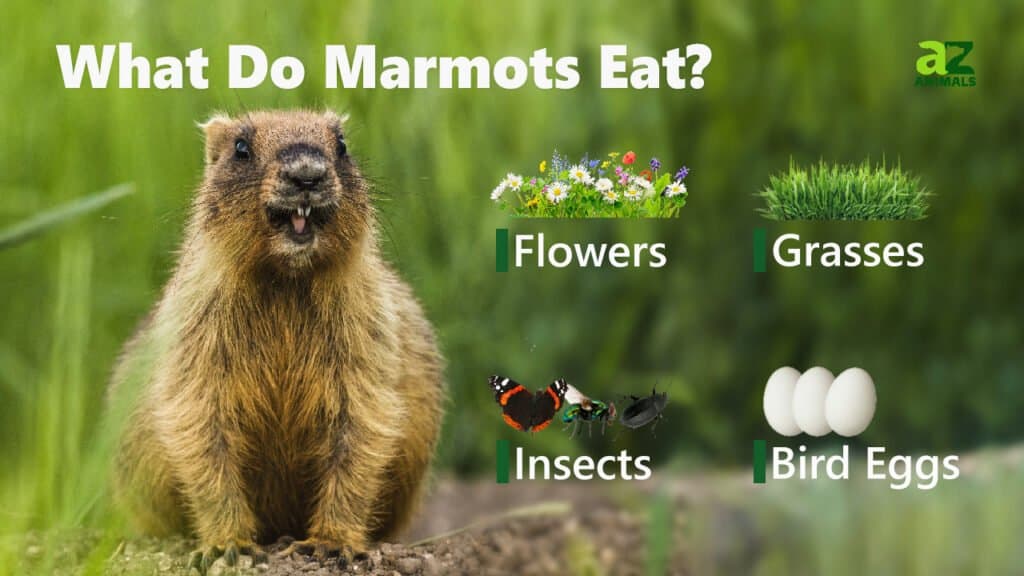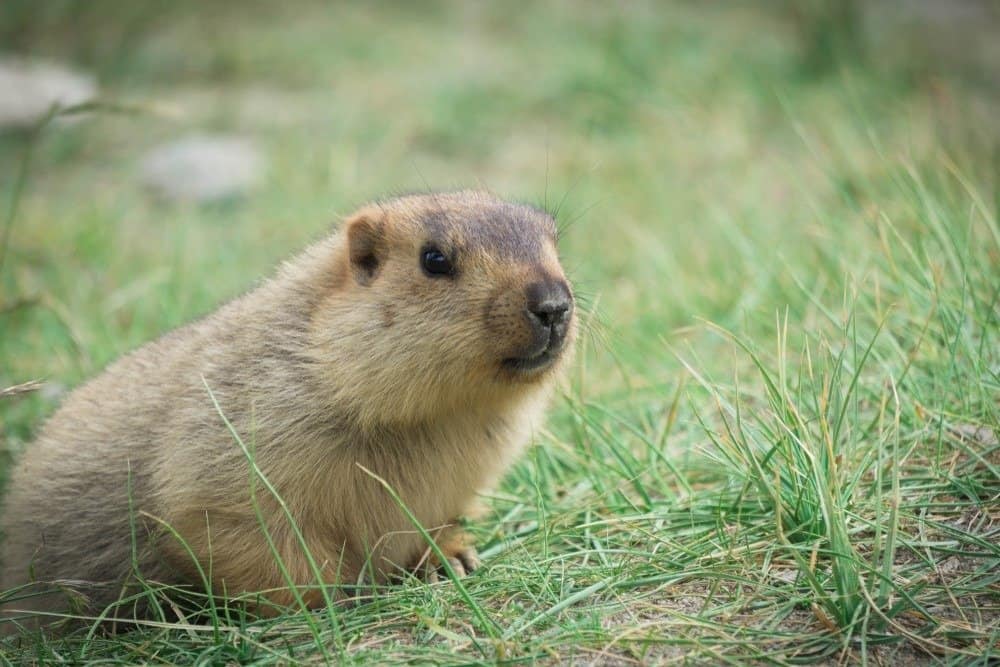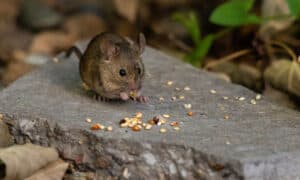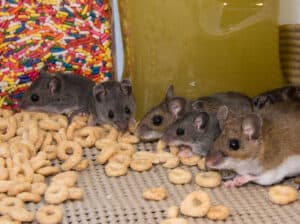Marmots are large ground squirrels which belong to the genus Marmota. They are actually considered the heaviest of the squirrel family, weighing in at about 11 pounds. Marmots have short legs with extremely large claws which they use for digging, and sharp incisors that help them eat lots of vegetation. They are at their most active throughout the day, particularly in the early and late afternoon.
You will usually find marmots on grassy plains and in the mountains. There are currently more than 15 species of marmot living in mountainous regions all throughout North America, Europe, and Asia. If you happen to live in the United States, you most likely would have run into the yellow-bellied marmot, as it is one of North America’s most frequent subspecies.
Now you may find yourself wondering, what exactly do marmots eat? Read on as we go over the diet of these fascinating creatures.
What Do Marmots Eat?

Marmots are omnivores that eat a diet that consists of grass, leaves, and other foods. As omnivores, they eat a variety of different things such as:
- Flowers
- Berries
- Leaves
- Grasshoppers
- Fruit
- Seeds
- Stems
- Grass
- Roots
- Bird eggs
Although omnivores, the bulk of a marmot’s diet is made up of plants, making them more herbivores than omnivores. Marmots usually hibernate, so they will consume everything they can find before hibernating.
In food choice studies, marmots have been seen rejecting plants carrying defensive chemicals. As a result, they eat the blooms of Lupinus, larkspur, and columbine but avoid the poisonous branches. Their dietary selection is influenced by the fatty acid and protein concentrations found in cinquefoil, cow-parsnip, and dandelion leaves, all of which are included in their diet. However, in the late summer, grasses, forbs, and seeds make up the majority of their diet.
Interestingly enough, marmots do not have to drink lots of water. This is because their plant diet meets the majority of their water needs.
How Much Do Marmots Need To Eat?

Marmots eat as much as they can before hibernating.
©fuyuna/Shutterstock.com
From September to May, marmots spend half of their lives hibernating. As a result, they must eat as much as possible in order to have enough fat stored to sustain them throughout this period. They will double their physical weight between spring and fall. Marmots will excavate exceedingly intricate burrows near rocks to utilize for hibernating and to hide from predators.
Marmot burrows may be up to 25 feet long! They love to live near rocks because they give adequate support for their burrows and also serve as a viewpoint for them as well as sun lounging areas. Marmots dwell in colonies with one another because they are incredibly gregarious creatures and will utilize one another to cuddle very close to lessen the amount of energy they exert during hibernation.
What Are The Marmots Predators?
Marmots must deal with a slew of predators, both on the ground and in the skies. Marmots have a very long list of predators to watch out for, which includes:
- Mountain lions
- Bears
- Coyotes
- Wolves
- Badgers
- Foxes
- Weasels
- Eagles
- Humans
Foxes and coyotes, in particular, are notorious for locating and waiting outside of marmot burrows to trap one when it emerges, looking for food. When they notice a predator, marmots utilize their fantastic whistles to notify other marmots in the area that there is a predator around.
When marmots are ready to hibernate, they will block all exits with dirt to prevent predators from locating their burrows. This also serves as a barrier against any chilly drafts.
Marmots are also preyed upon by humans. Marmot fur was once quite fashionable in Europe in the twentieth century, and marmots were collected and skinned for their fur.
While certain marmot species, such as the Vancouver Island marmot, are endangered, yellow-bellied marmots are not. Their numbers are very steady, and the IUCN classifies them as “least concern.”
Are Marmots Dangerous to People?

Marmots use a lookout to keep an eye out for predators. When a predator is seen, the lookout blows a loud whistle.
©Alexandre Boudet/Shutterstock.com
Marmots are not extremely hazardous to humans, but they have been known to bite if they feel threatened. Marmots are actually fairly afraid of humans and will leave you alone if you leave them alone. It is unlawful to keep them as pets.
Marmots have enormous teeth that, like other rodents, never stop growing. This is why they must continually gnaw, which helps strengthen their teeth. They have exceptionally huge and sharp claws that they employ for digging, in addition to keen teeth.
Marmots are sought for food in certain regions of the United States, but because they are rodents, they can also transmit illnesses that make them a threat to humans. Rocky Mountain Spotted Fever, Sylvatic Plague, and Cryptosporidiosis are among the illnesses that a marmot may carry. Instead of approaching these fuzzy critters, it is advisable to simply observe them from a safe distance.
How Does Their Diet Impact The Ecosystem
Understanding what marmots eat leads us to look into how they impact their habitats.
Recent studies have explored how marmots impact their habitats and the overall ecosystem. The studies found that marmots actually alter the structure and content of alpine plant communities. Marmots happen to be both the largest and the most widespread burrowing animals living in an alpine region.
Through their burrowing efforts, marmots improve alpine vegetation equitability and site heterogeneity. These rodents have a considerable influence on Ntot, Mg, K, and P concentrations in the soil. They have the greatest impact when creating their hibernation and maternity burrows. Marmot activity changes soil characteristics, reduces the dominance of common species, and hence increases community diversity.
Marmots may also function as seed dispersers and pollinators for the grasses and flowers they eat. While they roam around in subalpine meadows, they may gather pollens and disperse eaten seeds through their feces. Furthermore, they construct huge burrow systems that may be exploited by other species like insects and other small mammals.
The photo featured at the top of this post is © Kamal Hari Menon/Shutterstock.com
Thank you for reading! Have some feedback for us? Contact the AZ Animals editorial team.






